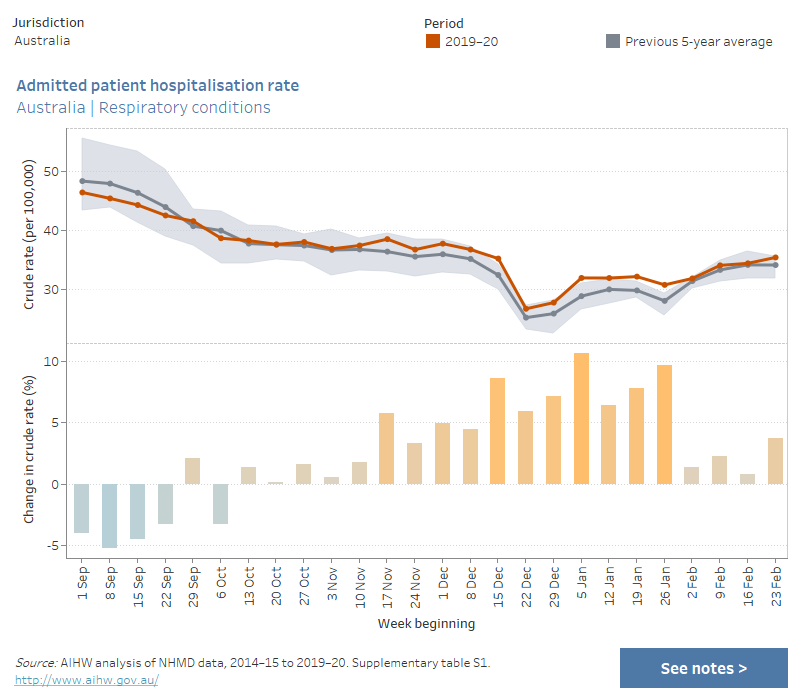Asthma
While asthma was included in the analysis of all respiratory conditions, hospitalisations with a principal diagnosis of asthma (ICD-10-AM codes J45—J46) were analysed separately, due to the known association between air pollution from bushfires and asthma (see Australian bushfires 2019–20: exploring the short-term health impacts).
Nationally, there were increases in the hospitalisation rate for asthma coinciding with increased bushfire activity during the 2019—20 bushfire season. The greatest increase was 36% in the week beginning 12 January 2020—2.4 per 100,000 persons (about 600 hospitalisations), compared with the previous 5-year average of 1.7 per 100,000 (an average of about 420 hospitalisations).
To explore national data and data for states and territories, see interactive data visualisations below (for data tables see Supplementary table S1).
Admitted patient hospitalisation rate, by jurisdiction, asthma (ICD-10-AM codes J45–J46), weeks in 2019–20 bushfire season relative to previous 5-year average
This combined chart shows the crude rate of admitted patient hospitalisations (per 100,000 persons) for asthma for the periods 2019–20 and the previous 5-year average, and the percentage change in crude rate between the two periods. Data are presented by jurisdiction and by week, for the period 1 September to 29 February/1 March, which correspond to the bushfire season. The chart shows that nationally, compared with the previous 5-year average, the greatest increase in the hospitalisation rate was 36% in the week beginning 12 January 2020. There were also variations at the jurisdictional level.

At the state and territory level, examples of large increases in the hospitalisation rate for asthma coinciding with periods of significant fire activity or air pollution include:
- a 25% increase in the week beginning 8 December 2019 for New South Wales residents—3.1 per 100,000 persons (about 255 hospitalisations), compared with an average of 2.5 per 100,000 in the previous 5-year period (an average of about 195 hospitalisations). There was also a 25% increase in the rate of hospitalisations in the week beginning 5 January 2020
- a 95% increase in the week beginning 12 January 2020 for Victorian residents—3.4 per 100,000 persons (about 220 hospitalisations), compared with an average of 1.7 per 100,000 in the previous 5-year period (an average of about 105 hospitalisations)
- a 36% increase in the week beginning 10 November 2019 for Queensland residents—3.9 per 100,000 persons (about 200 hospitalisations), compared with an average of 2.9 per 100,000 in the previous 5-year period (an average of about 140 hospitalisations). This coincided with a period of thick smoke from fires in northern New South Wales, which covered south-east Queensland and triggered a public health warning to stay indoors (ABC News 2019).
Numbers of hospitalisations for asthma at the level of Statistical Area Level 4 (SA4) were generally small and should be considered with caution. However, some notable examples of increases in the hospitalisation rate, coinciding with periods of significant fire activity or air pollution include:
- a 75% increase in the week beginning 10 November 2019 for Newcastle and Lake Macquarie residents—5.3 per 100,000 persons (20 hospitalisations), compared with an average of 3.0 per 100,000 in the previous 5-year period (an average of 11 hospitalisations)
- about a 135% increase in the week beginning 12 January 2020 for Melbourne – West residents—4.4 per 100,000 persons (37 hospitalisations), compared with an average of 1.9 per 100,000 in the previous 5-year period (an average of 14 hospitalisations)
- a 94% increase in the week beginning 24 November 2019 for Ipswich residents—6.1 per 100,000 persons (22 hospitalisations), compared with an average of 3.1 per 100,000 in the previous 5-year period (an average of 10 hospitalisations).
For data by Statistical Area Level 4 (SA4), see Supplementary table S2.
References
ABC (Australian Broadcasting Corporation) News 2019. Queensland fire emergency leaves Brisbane’s air quality worse than Beijing. Viewed 15 June 2020.


